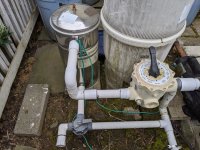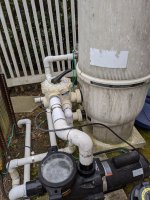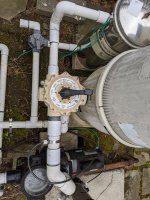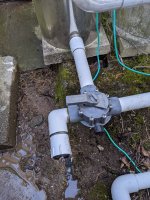How do I backwash the pictured system? Last time I opened the backwash bucket the net in there was good and clean.
I am guessing, turn off pump, switch to backwash on main knob and then switch the bottom nob to have off point to return line. Then turn on pump for 90 seconds. I should see clear water or maybe cloudy coming out of the bottom T .
Then switch main knob to filter and turn on pump for 90 seconds. I should see clear water coming out of the bottom T.
I'll repeat about 3 times. Then finally switch main knob to filter and bottom know to original position.
One other question is that during normal operation it appears to me that this tank gets filled with water and then returns in to the return line. Is that normal? Intuitively, I would expect it to be bypassed during filter operation. Or do I have it setup wrong?
I am guessing, turn off pump, switch to backwash on main knob and then switch the bottom nob to have off point to return line. Then turn on pump for 90 seconds. I should see clear water or maybe cloudy coming out of the bottom T .
Then switch main knob to filter and turn on pump for 90 seconds. I should see clear water coming out of the bottom T.
I'll repeat about 3 times. Then finally switch main knob to filter and bottom know to original position.
One other question is that during normal operation it appears to me that this tank gets filled with water and then returns in to the return line. Is that normal? Intuitively, I would expect it to be bypassed during filter operation. Or do I have it setup wrong?





